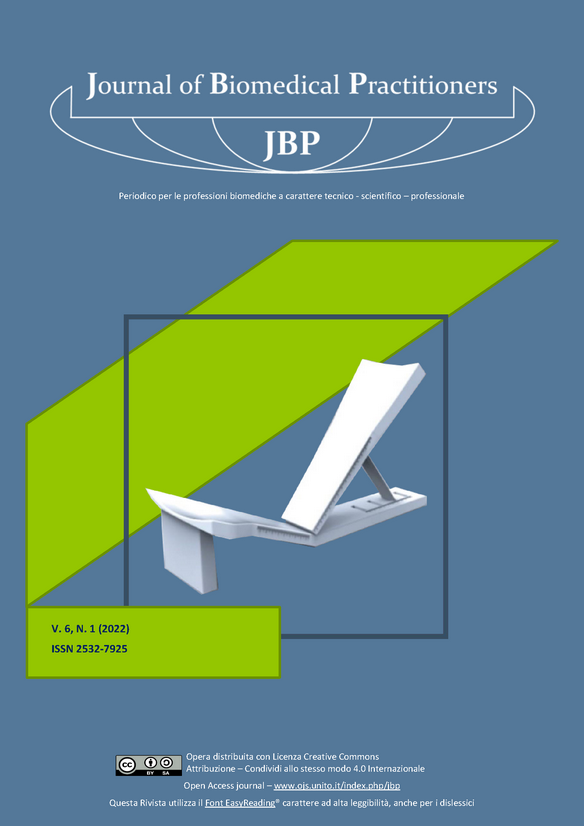L’importanza della comunicazione aumentativa alternativa e il suo impatto nella qualità di vita dei pazienti affetti da SLA.
Contenuto principale dell'articolo
Abstract
INTRODUZIONE
Questo lavoro di ricerca prende in esame pazienti affetti da Sclerosi Laterale Amiotrofica (SLA), con l’obiettivo di verificare come l’utilizzo di ausili di comunicazione aumentativa alternativa (CAA) consentono alla persona di interagire con l’ambiente e con i vari partner comunicativi, migliorando la loro qualità di vita.
MATERIALI E METODI
Sono stati presi in esame n.11 pazienti con diagnosi di SLA, ai quali è stato somministrato il test AAC Device Trial Checklist & Rubric, ripetuto a distanza di sei mesi. Il test consente di valutare la capacità da parte del paziente di utilizzare il sistema di comunicazione aumentativa alternativa di cui dispone, in uno o più ambienti comunicativi e con uno o più partner comunicativi.
RISULTATI
I risultati della ricerca, in linea con le evidenze scientifiche di settore, hanno rivelato che i pazienti presi in esame hanno tratto beneficio dall’utilizzo di ausili di comunicazione aumentativa alternativa. Dalle valutazioni effettuate si riscontrano risultati migliori (100% dei casi) nell’utilizzo del sistema di CAA in due ambienti e con almeno 2 partner comunicativi. L’82% dei casi mostra dei miglioramenti nell’utilizzo della CAA per la richiesta di oggetti e azioni. Il 72,7% dei casi mostra miglioramenti nell’utilizzo della CAA per gli scopi comunicativi legati all’espressione di emozioni e/o per richiamare l’attenzione del partner comunicativo.
DISCUSSIONE
La ricerca sottolinea attraverso i risultati quanto sia importante l’utilizzo dei sistemi di CAA in persone con disabilità del linguaggio espressivo e di quanto risulti fondamentale il ruolo del logopedista nel progetto di CAA. Il logopedista, infatti, estende la propria azione professionale alla valutazione delle funzioni neurolinguistiche potendo così contribuire grandemente alla conoscenza delle caratteristiche individuali della disabilità della persona.
CONCLUSIONI
Una corretta presa in carico multidisciplinare, che includa una valutazione delle competenze comunicative del soggetto e la scelta dell’ausilio di CAA più adeguato, nelle condizioni in cui l’eloquio della persona risulti essere intellegibile, migliora l’interazione e il coinvolgimento della persona con i diversi partner comunicativi e l’ambiente esterno, migliorando di conseguenza la qualità di vita della persona
Downloads
Dettagli dell'articolo
Gli autori mantengono i diritti sulla loro opera e cedono alla rivista il diritto di prima pubblicazione dell'opera, contemporaneamente licenziata sotto una Licenza Creative Commons - Attribuzione che permette ad altri di condividere l'opera indicando la paternità intellettuale e la prima pubblicazione su questa rivista.
Riferimenti bibliografici
[2] A. Bua, L.U. Collovà, A.Lombino, A.Petronaci, D. Sprini., “Sclerosi Laterale Amiotrofica (SLA): valutazione della disfagia e gestione degli aspetti nutrizionali”, (2020), in Journal of Biomedical Practitioners, numero 1, vol. 4 (2020): 36-55.
[3] Fried-Oken, Melanie et al. “Supporting communication for patients with neurodegenerative disease.” NeuroReha-bilitation vol. 37,1 (2015): 69-87.
[4] Beukelman, David R., and Pat Mirenda. "Manuale di comunicazione aumentativa e alternativa." adulti con com-plessi bisogni comunicativi. Trento: Erickson (2014).
[5] Borasio, G. D., & Miller, R. G. “Clinical characteristics and management of ALS.” (2001). Seminars in Neurolo-gy, 21, 155 – 166.
[6] Lisiecka D, Kelly H, Jackson J. “How do people with Motor Neurone Disease experience dysphagia? A qualitative investigation of personal experiences.” (2019). Disability and rehabilitation. Sep 24:1-0.
[7] Kidney, Deirdre, et al. "Oropharyngeal dysphagia in amyotrophic lateral sclerosis: neurological and dysphagia specific rating scales." Amyotrophic Lateral Sclerosis and Other Motor Neuron Disorders 5.3 (2004): 150-153.
[8] Allison, Kristen M., et al. "The diagnostic utility of patient-report and speech-language pathologists’ ratings for detecting the early onset of bulbar symptoms due to ALS." Amyotrophic Lateral Sclerosis and Frontotemporal De-generation 18.5-6 (2017): 358-366.
[9] R. Favole, C. Isaia, R. Muò, S. Trabucchi, Pasian V. “Comunicazione Aumentativa Alternativa (CAA) negli adulti.” (2018).
[10] Package, WATI Assessment. "WATI Assessment Package." (2004).
[11] Mercurio-Standridge, Angela. "Conducting AAC assessments with competence." Perspectives on Augmentative and Alternative Communication 23.2 (2014): 75-83.
[12] Mathy, P., and K. Yorkston. "Gutmann. AAC for individuals with amyotrophic lateral sclerosis." (2000). Aug-mentative and alternative communication for adults with acquired neurologic disorders: 183-232.
[13] Yorkston, K., Strand, E., Miller, R., Hillel, A., & Smith, K. “Speech deterioration in amyotrophic lateral sclerosis: Implications for the timing of intervention.” (1993). Journal of Medical Speech-Language Pathology, 1, 35 – 46.
[14] Light, J. “Interaction involving individuals using augmentative and alternative communication systems: State of the art and future directions.” (1988). Augmentative and Alternative Communication, 4, 66 – 82.
[15] Corradi, F., Castellano, G., Luciani, N., Gasperini, M., & Caretto, F. ISAAC Italy “PRINCIPI E PRATICHE in CAA” (2018).
[16] Doyle, M., & Phillips, B. “Trends in augmentative and alternative communication use by individuals with amyo-trophic lateral sclerosis.” (2001) Augmentative and Alternative Communication, 17(3), 167 – 178.
[17] Ball, L. J., Beukelman, D. R., & Pattee, G. L. “Acceptance of augmentative and alternative communication tech-nology by persons with amyotrophic lateral sclerosis.” (2004). Augmentative and Alternative Communication, 20(2), 113 – 122.
[18] Melanie Fried-Oken, Lynn Fox, Marie T. Rau, Jill Tullman, Glory Baker, Mary Hindal, Nancy Wile & Jau-Shin Lou. “Purposes of AAC device use for persons with ALS as reported by caregivers.“ (2006). Augmentative and Alter-native Communication, 22:3, 209-221.
[19] McNaughton, D., Light, J., & Groszyk, L. “Don’t give up: Employment experiences of individuals with amyotrophic lateral sclerosis who use augmentative and alternative communication.” (2001). AAC Augmentative and Alternati-ve Communication, 17, 179 – 195.

